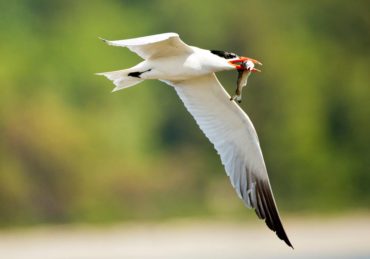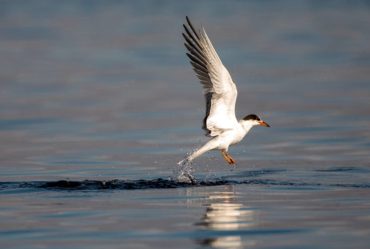
The summer months bring numerous visitors to West Sound’s shorelines. Some enjoy beach walks, while others prefer a picnic. Boats abound and kites fly high.
The wintering waterfowl have long since departed and are raising their families in the sunny Arctic. Marine birds that winter in the South are here for the summer. Among the latter are Caspian and common terns, close relatives of gulls.
Terns are gregarious birds that are often found on beaches, foraging and resting alongside gulls. But unlike gulls, who eat practically anything while looking for their meals in natural habitat, garbage dumps and everywhere in between, terns tend to be a bit more dignified, eating only the fish they catch.
A variety of prominent features distinguish terns from gulls. These include slender bodies, long and pointed wings, short legs, a pointy red/orange bill and black cap atop a white head.
The unmistakable Caspian tern is most easily recognized by its size. With an impressive 4-foot wingspan, it’s the largest tern in the world. Black legs are also a good field mark. Its croaky voice would never win a singing contest but can be heard loud and clear in flight.
As one of the most widespread of the world’s 40 tern species, Caspian terns can be found on any continent, except Antarctica. Despite this, populations around the world are in peril, particularly in Europe and Africa. This is primarily due to nest disturbance, as Caspian terns will abandon breeding colonies when threatened.

The Caspian tern is currently listed as “monitored” on the Washington state endangered species list. Researchers closely watch population shifts.
In the last 50 years, scientists have observed that Caspian terns along the Pacific Coast have been moving northward. Estimates show that over 70 percent of these Pacific Coast breeders nest in the Columbia River estuary. Since Caspian terns prefer to nest on islands with minimal vegetation, they’re attracted to the estuary’s small islands that have been created by river dredging.
The world’s largest breeding colony of Caspian terns is near the mouth of the Columbia River on Oregon’s East Sand Island, just offshore from Chinook, Washington. More than 6,000 pairs breed there each year. The same island is also home to the world’s largest breeding colony of double-crested cormorants.
Caspian terns aren’t known to nest along shorelines of the Salish Sea, so summer residents of West Sound are usually nonbreeding adults that winter in Mexico. Although they are common on Puget Sound shorelines, Caspian terns are rarely spotted on Hood Canal. They are common summer residents of Eastern Washington, with many pairs breeding along the Columbia River.
Despite its name, the common tern is less common in West Sound than its Caspian cousin. The most widespread of all North American terns, the common tern breeds across central and eastern Canada and winters in South America.
In Washington, common terns pass through during migration. In spring, they usually travel along the outer coast. Late summer and fall migrants journey along both the outer and inner coastlines, with some individuals even venturing inland over the Cascades and the Columbia Plateau.
In West Sound, common terns are considered uncommon migrants in August and September, with a few stragglers flying by in October. Bainbridge Island beaches, the Kingston/Edmonds ferry, and Point No Point and Norwegian Point county parks in Hansville are the best places to look for them.
Common terns are most easily distinguished from Caspian terns by their smaller size, orange legs and forked tail. In the nonbreeding season, the common tern develops a white forehead and a blackened bill and legs.
Terns are known for their incredible flying abilities. They fly over the water on graceful wingbeats with head pointed down, looking for fish near the surface. When it spots one, the tern will hover, fold in its wings and dive toward the unsuspecting fish. After a few seconds, the tern will explode out of the water either with a fish in its bill or the resolve to try again.
Compared to the relatively ordinary migration routes of the Caspian and common terns, their cousin, the Artic tern, goes the most remarkable distance. Traveling from the Arctic to Antarctica and back each year to experience perpetual summer, this extraordinary navigator can put up to 50,000 miles a year on its odometer. In a 30-year lifespan, the Arctic tern can fly the equivalent of three round trips to the moon.
Terns face the same challenges as other seabirds. They need breeding grounds and foraging waters free of pollution and human disturbance. Increased conservation efforts are helping to address these issues.
Those who tire of squawking gulls would enjoy West Sound’s Caspian and common terns. These elegant flyers enhance our shorelines with their beauty and dazzling dives. Now playing for a limited time only. Don’t miss the show.






























Comments